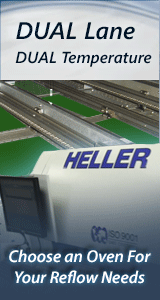Printed Circuit Board Assembly & PCB Design Forum
SMT electronics assembly manufacturing forum.
- SMTnet
- »
- Electronics Forum
- »
- Immersion Gold over Nickle de-wetting problem
Immersion Gold over Nickle de-wetting problem
![]() Hi,
I'm experiencing a problem on a standard part made many...
- Mar 06, 2003
by
Hi,
I'm experiencing a problem on a standard part made many...
- Mar 06, 2003
by
![]()
![]()
![]() Greetings Sir,
Although I am not qualified to address the i...
- Mar 06, 2003
by
Greetings Sir,
Although I am not qualified to address the i...
- Mar 06, 2003
by
![]()
![]() O' Connor: Are you saying that:
* You solder fine in the a...
- Mar 06, 2003
by
davef
O' Connor: Are you saying that:
* You solder fine in the a...
- Mar 06, 2003
by
davef
![]()
![]()
![]() Hi Again,
In answer to DaveF -
Yes solder is fine where t...
- Mar 07, 2003
by
Hi Again,
In answer to DaveF -
Yes solder is fine where t...
- Mar 07, 2003
by
![]()
![]()
![]() Hi O'Conner,
I hope you also tell us what Universal-Georg...
- Mar 07, 2003
by
Hi O'Conner,
I hope you also tell us what Universal-Georg...
- Mar 07, 2003
by
![]()
![]()
![]() YiEng, MA/NY DDave: Usually when the gold plating bath goes ...
- Mar 07, 2003
by
davef
YiEng, MA/NY DDave: Usually when the gold plating bath goes ...
- Mar 07, 2003
by
davef
![]()
![]()
![]() O'Connor: IPC-A-610, section 12.4.4 SMT Soldering Anomolies ...
- Mar 07, 2003
by
davef
O'Connor: IPC-A-610, section 12.4.4 SMT Soldering Anomolies ...
- Mar 07, 2003
by
davef
![]()
![]()
![]() Remember the gold is only deposited to provide an air barrie...
- Mar 07, 2003
by
Remember the gold is only deposited to provide an air barrie...
- Mar 07, 2003
by
![]()
![]()
![]() Hi
Yes DavidF I agree, and that is what I think I am read...
- Mar 08, 2003
by
Hi
Yes DavidF I agree, and that is what I think I am read...
- Mar 08, 2003
by
![]()
![]()
![]() Hi
The other thing the Ni does is to create a time barrie...
- Mar 08, 2003
by
Hi
The other thing the Ni does is to create a time barrie...
- Mar 08, 2003
by
![]()
![]()
![]() Which specific title books from under your pen, would you re...
- Mar 09, 2003
by
iman
Which specific title books from under your pen, would you re...
- Mar 09, 2003
by
iman
![]()
![]()
![]() Hi
Well I don't have all the titles right handy, yet let ...
- Mar 10, 2003
by
Hi
Well I don't have all the titles right handy, yet let ...
- Mar 10, 2003
by
![]()
![]()
![]() Look at "Dave's Book Shelf" here: ...
- Mar 11, 2003
by
Look at "Dave's Book Shelf" here: ...
- Mar 11, 2003
by
![]()
![]() Hey Neat,
We share some of the same books, although I wou...
- Mar 11, 2003
by
Hey Neat,
We share some of the same books, although I wou...
- Mar 11, 2003
by
![]()
![]()
![]() Hi
As I got thinking about your problem, as you stated it...
- Mar 11, 2003
by
Hi
As I got thinking about your problem, as you stated it...
- Mar 11, 2003
by
![]()
![]()
![]() Everybody thanks for all your help, the problem has been sol...
- Mar 12, 2003
by
Everybody thanks for all your help, the problem has been sol...
- Mar 12, 2003
by
![]()
![]()
![]() O' Connor
Haaa. It's usually the design guys that foist...
- Mar 12, 2003
by
davef
O' Connor
Haaa. It's usually the design guys that foist...
- Mar 12, 2003
by
davef
![]()
![]()
![]() Hi
Thanks more than you know for your honesty.
Honesty...
- Mar 12, 2003
by
Hi
Thanks more than you know for your honesty.
Honesty...
- Mar 12, 2003
by
![]()
O' Connor
- SMTnet
- »
- Electronics Forum
- »
- Immersion Gold over Nickle de-wetting problem







